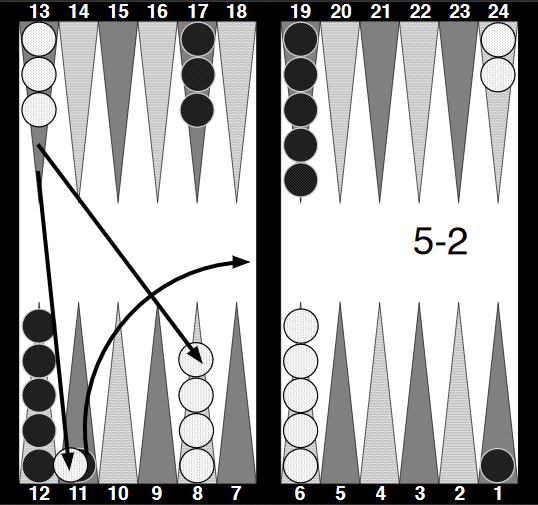Last updated on October 30, 2022
This Deluxe Backgammon post is another in our series for absolute beginners. In this instance, we look at how to hit your opponent’s checkers and why it is such a good play.
As you move your checkers around the board in backgammon, you should always be on the lookout for blots. These are points occupied by only one of your opponent’s checkers. These checkers are vulnerable as they can be hit and sent to the bar. Any time a player has one or more checkers on the bar, their first obligation is to re-enter the checker(s). A checker is entered by moving it to an open point corresponding to one of the numbers on the rolled dice. If the opposing home board is closed (all points are occupied by two or more opposing checkers) the player cannot re-enter. They forfeit their turn and remain on the bar. In the example below, black has opened with a 6-4 and moved a back checker forward. White replies with 5-2, allowing a hit on black using the roll of 2, sending it to the bar. The second checker is moved from 13 to 8.
Hitting
At its heart, backgammon is a racing game. When you hit an opponent’s checker you effectively send that piece back to the beginning of the race. This creates a huge advantage, particularly if you hit a checker in your opponent’s home board. Imagine that your opponent has moved one of their back checkers all of the way into their home board and then you hit it. That will send the checker back to the bar, losing twenty pips. They then need to run the checker all of the way around the board again, after re-entering. This confers a massive advantage, which is multiplied if you can hit more than one checker. The general rule of thumb in backgammon is to take every opportunity you can for hitting your opponent’s checkers.
For example, if your turn allows you to land on a blot, you score a hit, and your opponent’s checker must move to the bar. Before they can do anything else, they must re-enter the checker into the opposing home board. To do this, they must be able to move to an open point corresponding to one of the numbers rolled on the dice. For example, if the 1, 2 and 3-points were open, they would need to make a roll that would allow them to move to one of those points. If they rolled a 4 and a 6, they wouldn’t be able to re-enter. However, if they rolled 5 and 2, they could move the checker from the bar and re-enter on the 2-point.
Hitting multiple checkers
Imagine if you were able to hit two or more of your opponent’s checkers and send them to the bar. In theory, if you rolled a double, you could potentially hit four of your opponent’s checkers. They must re-enter all of them before they can make any other moves. If they are able to enter some, but not all, of their checkers. They must enter as many as possible and then forfeit the remainder of their turn. After they have re-entered all of their checkers, they may continue playing the remaining numbers on the dice by moving any of their checkers on the board.
Hitting is what makes backgammon challenging and exciting. As you try to hit your opponent’s checkers, they are trying to hit yours, too. Generally, the most thrilling games of backgammon are those where both players are hitting their opponent’s checkers. Always remember that backgammon is, at its core, a racing game. You are trying to race your checkers to your home board so you can bear them off before your opponent does the same. If you can slow your opponent down by hitting their checkers, you dramatically increase your chances of winning the race.
Related content
Take a look at some of our other Playing Guides to help improve your game.
Backgammon rules are available on this link.
Wikipedia, backgammon hitting.



Its a useful post for backgammon beginners. Every time you hit, you send your opponent backwards in the race. There are situations where you shouldn’t hit, but in backgammon, it is generally a good idea. Thanks for all of the backgammon playing guides, they have been really helpful, my backgammon game has improved since reading them.
Hi Kendal, we are pleased you found this post useful. Here is a summary post on how to improve your backgammon. Thanks for taking the time to comment, Jason.
Can you send two of the opponent’s checkers to the bar with the same checker (i.e., if you move three and land on a single checker of your opponent, and then move four with that same check and land on another of your opponent’s checkers?) Or do you only count the final resting place of your checker for a turn?
Hi Adam, in backgammon you can hit both checkers and send them both to the bar. In fact in backgammon, if you can hit two checkers it is almost always worth doing. Unless, you have multiple blots in your home board, it is probably the best choice. Thanks for taking time to comment, Jason